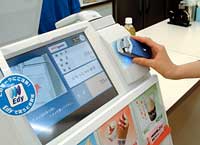|
|
|||||||
|
|
|||||||
|
|||||||
| | Web Japan >> | Trends in Japan >> | Business & Economy >> | Wallet Phones | |
|
WALLET PHONES Cell Phones with IC Chips Replace Cash, Cards, and Keys (November 29, 2004) Cell phones that allow users to pay for their shopping just by holding them over a reader at the cash register, aptly nicknamed o-saifu keitai (wallet cell phones), went on the market in July 2004. Sold by NTT DoCoMo, the phones contain a noncontact IC chip called FeliCa developed by Sony Corp. Aside from functioning as electronic money, the versatile new phones are capable of replacing credit cards, membership cards, reward cards, and even the keys to the office or home. Shop Cashless, Ride Cashless The J-Wave radio station offers a digital membership card service that can be used by downloading the J-Wave Pass to one's wallet phone. The phone can then serve as an electronic ticket to live concerts and other events; users just hold their phones against a reader at the gate, and in they go. With Karaoke Dam, a network karaoke system maintained by Daiichikosho, customers at karaoke rooms can enjoy various types of interactive entertainment once they have signed up for membership through the i-Mode Internet service accessible from NTT DoCoMo's i-Mode cell phones. Kokunai Shinpan Co. and Hayakawa Estate, meanwhile, employ a system whereby wallet phones function as keys to the front doors of individual apartments. Credit card company JCB hopes to begin using the wallet phones in-house by fall 2004. It plans to monitor the movements of employees in and out of the office by using the phones as room keys, as well as to realize a cashless environment by introducing the system in the company cafeteria. By March 2005 members of the Pia ticketing service will be able to buy, pay for, and download tickets using their wallet phones, so that all they will need to enter the gates at movie theaters and concert venues will be their cell phones. The JR East railway company also plans to begin use of wallet phones as train tickets and commuter passes by the latter half of fiscal 2005. Deposit and Payment Needless to say, one must deposit money to the wallet phone's account before the e-money function can be used. There are two ways of doing this. One is to deposit cash at an Edy affiliated store and transfer the information into one's phone using a reader-writer. The other is to deposit money electronically by connecting the phone to an Edy-issuing website that is partnered with a credit card company. Up to ¥50,000 can be stored in the wallet phone at one time. When a customer is done shopping at an affiliated store, he or she holds the phone over a reader-writer at the checkout counter. The machine produces a sound imitating the bell of a classic cash register, and payment is completed within seconds. Users can check their account balance and shopping history on their phone screens at any time. If wallet phones gain wide currency, e-money companies - which have hitherto won customers mainly through Internet websites designed for access by personal computers - will likely shift their focus to cell phone users. The competition among e-money companies looks set to intensify in this new arena. Copyright (c) 2004 Web Japan. Edited by Japan Echo Inc. based on domestic Japanese news sources. Articles presented here are offered for reference purposes and do not necessarily represent the policy or views of the Japanese Government. |
IT STARTED AS A PHONE (July 17, 2003) AN EMERGING "THUMB CULTURE" (January 10, 2003) TOWARD A TICKETLESS STATION (January 8, 2002) IT'S A CAMERA, A STEREO, AND A TRAIN TICKET (February 7, 2001) |
|
|




